
Petrozavodsk is the capital city of the Republic of Karelia, Russia, which stretches along the western shore of Lake Onega for some 27 kilometers (17 mi). The population of the city is 280,890 as of 2022.

The national flag of the Russian Federation is a tricolour of three equal horizontal fields: white on the top, blue in the middle, and red on the bottom. It was first raised in 1696, as an ensign for merchant ships under the Tsardom of Russia.

A yacht club is a boat club specifically related to yachting.

Shlisselburg, formerly Oreshek (Орешек) (1323–1611) and Petrokrepost (Петрокрепость) (1944–1992), is a town in Kirovsky District, Leningrad Oblast, Russia, located at the head of the Neva River on Lake Ladoga, 35 kilometers (22 mi) east of St. Petersburg. Population: 13,170 (2010 Census); 12,401 (2002 Census); 12,589 (1989 Census).
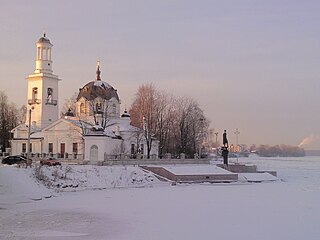
Ust-Izhora is a municipal settlement in Kolpinsky District of the federal city of St. Petersburg, Russia, situated at the confluence of the Izhora and Neva Rivers, and is roughly equidistant to St. Petersburg and Shlisselburg, Russia, 30 kilometers (19 mi) from both the Gulf of Finland in the west and Lake Ladoga in the northeast. Population: 1,354 (2010 Census); 1,152 (2002 Census); 1,378 (1989 Census).
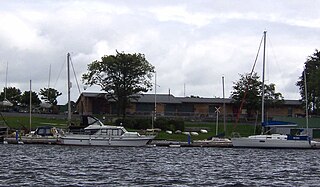
Lough Ree Yacht Club is a sailing club based in Ballglass, Coosan, near Athlone, Ireland. Founded in 1770, albeit under the name Athlone Yacht Club, it claims to be one of the oldest yacht clubs in the world, although another Irish yacht club, The Royal Cork Yacht Club has proven to be the world's first and oldest yacht club. In any event it is probably the oldest club based on an inland lake.

The Royal Cork Yacht Club is a yacht club located in Crosshaven, County Cork, Ireland. Founded in 1720, it is a claimant to the title of the world's oldest yacht club, although this is challenged by the Neva Yacht Club in Russia.
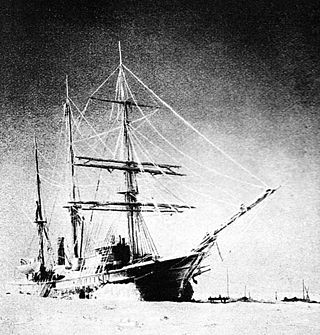
Zarya was a steam- and sail-powered brig used by the Russian Academy of Sciences for a polar exploration during 1900–1903.
The appearance of Saint Petersburg includes long, straight boulevards, vast spaces, gardens and parks, decorative wrought-iron fences, monuments and decorative sculptures. The Neva River itself, together with its many canals and their granite embankments and bridges help to give the city its particular ambience.

Sport in Saint Petersburg has a long tradition, back to the founding days of Saint Petersburg in the early 18th century.

Nikolai Vekšin was a Russian and Estonian sailor and helmsman of the bronze-medallist Estonian team at the 1928 Amsterdam Olympic Games.

Ihor Matviienko is a Ukrainian sailor and Olympic Champion. He won a gold medal in the 470 class at the 1996 Summer Olympics in Atlanta, together with Yevhen Braslavets. He also competed at the 2000 Summer Olympics and the 2004 Summer Olympics. Also, Matviienko is the World and European Champion in 2001. He is a President of the Sailing Federation of the Dnipro, President of 470 class association of Ukraine and Founder of sailing school and club MIR yacht club in Dnipro, Ukraine.
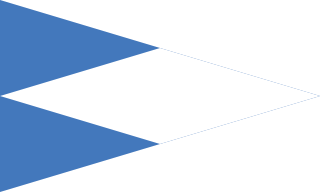
The St. Petersburg River Yacht Club, also known as St. Petersburg Central River Yacht Club or simply Central River Yacht Club, is a sailing club in Saint Petersburg. It is located on Petrovsky Island, off Peter's Passage, between the mouths of Malaya Neva and Malaya Nevka rivers. The Naval Yacht Club is close by.
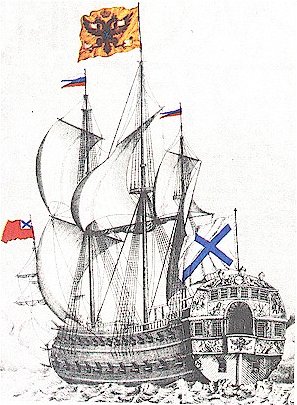
Poltava was a 54-gun ship of the line of the Imperial Russian Navy that was launched on 15 June 1712 from Saint Petersburg. The ship was named after an important for Russia victory over the Swedish Empire in the Battle of Poltava and became the first battleship laid down and built at the St. Petersburg Admiralty. In the 1710s, the ship was sometimes visited and commanded by Peter I, who also took active part in the design and construction of the ship. During her service of 1712–1732, Poltava was part of the Baltic Fleet, and before the end of Great Northern War participated in six marine campaigns. She was later used for training Kronstadt crews in the Baltic Sea. Poltava was decommissioned in 1732.
Yachts club SMTU was an educational yacht club on Kirov Islands of St. Petersburg. It occupied the island of Bezymyanniy.
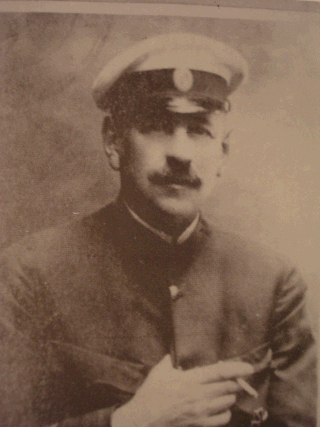
Prince Esper Konstantinovich Beloselsky-Belozersky was a prince and sailor from Russia, who represented his native country at the 1912 Summer Olympics in Nynäshamn, Sweden. Beloselsky took the bronze in the 10 Metre.
Ernst Konrad Otto Brasche was an Estonian physician, sport sailor, and chess player who participated as part of the Imperial Russian sailing team at the 1912 Summer Olympics in Nynäshamn, Sweden. Brasche and his team members took a bronze medal in the 10 Metre regatta.
Karl Fredrik Lindholm was a sailor from the Grand Duchy of Finland, who participated as part of the Russian imperial sailing team at the 1912 Summer Olympics in Nynäshamn, Sweden. He then lived in Saint Petersburg, Russian Empire, and this team of the local yacht club was his team. Lindholm and his six team members took a bronze medal for the Russian Empire in the 10 Metre regatta. Lindholm was born in Turku, and he was a Swedish-speaking Finn.

Nikita Petrovich Villebois was a Russian Vice-Admiral of French origin. Father General feldtseyhmeyster Alexander Villebois.
















